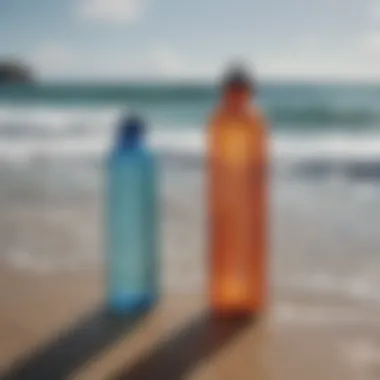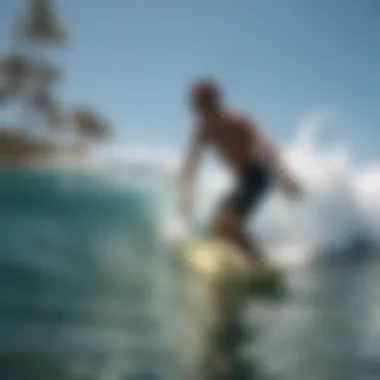Recognizing Dehydration Signs in Surfers


Intro
Surfing is not just a sport; it’s a lifestyle. The ocean calls to many, offering both escape and excitement. However, while the thrill of riding waves can dominate your thoughts, it’s crucial to stay aware of your body’s signals. Dehydration subtly creeps in, often unnoticed, until it starts to hinder your performance.
Being in the water for long periods under the sun can lead to diminished hydration levels, which can affect your stamina and overall enjoyment. Surfers, with their rigorous activity and exposure to the elements, face unique risks when it comes to hydration. The importance of identifying the signs of dehydration is paramount. A surfer's ability to gauge their hydration status not only aids in maintaining peak performance but also safeguards their health in and out of the water.
Let’s dive into what dehydration looks like, how to recognize it amidst all the other sensations of surfing, and what you can do to keep yourself topped up with fluids while enjoying your time on the waves.
Understanding Dehydration
Dehydration is more than just a thirsting throat or dry lips; it can sneak up on even the most seasoned surfers. Understanding dehydration is crucial because it significantly influence both performance and safety while riding the waves. Surfing can be immensely physically demanding, combined with sun exposure and sweltering temperatures, all of which make hydration a critical consideration. In this section, we delve into what dehydration really means, its various causes, and how it specifically impacts surfers.
Defining Dehydration
Dehydration occurs when the body loses more fluids than it takes in. This imbalance can slowly build up, often unnoticed, causing various symptoms that can affect overall well-being. Simply put, our bodies require water to function optimally. It's involved in everything from digestion to regulating body temperature. When surfing, maintaining fluid balance is especially vital due to the exertion and heat, making understanding dehydration a key element for anyone who surfs.
Causes of Dehydration
Dehydration doesn't just happen overnight; it stems from various factors, three of which are particularly relevant to surfers.
Environmental Factors
The sun and heat undoubtedly play a huge role in dehydration. When surfers are out under a blazing sun, they tend to sweat more, losing essential water and electrolytes. The key characteristic of environmental factors is that they’re often unavoidable. Minutes under direct sunlight can lead to quick fluid loss, especially in summer months.
One unique feature to consider is humidity—or lack thereof. Surfers in arid regions may find themselves dehydrating faster than those in humid environments. Thus, recognizing the environmental conditions can be a game changer in combating dehydration.
Physical Activity
The vigorous activity of paddling, popping up, and riding the waves contributes heavily to the risk of dehydration. High levels of exertion increase sweat rates, and coupled with the sun, it’s a cocktail for fluid loss.
One reason this factor stands out is due to the intensity of surfing. Unlike many other sports, surfing incorporates stamina, strength, and agility over a prolonged period. This demands more hydration. Understanding the physical toll surfing takes helps underscore the necessity of constantly replacing lost fluids.
Poor Hydration Habits
Not drinking enough fluids, or sustaining bad hydration habits, is another crucial contributor to dehydration among surfers. Some may think they can wait until they feel thirsty to drink, but by then, they might already be in the early stages of dehydration.
This is a key characteristic of poor hydration habits; procrastination when it comes to drinking can lead to a downward spiral. Surfers who find themselves engrossed in waves may forget to hydrate regularly. The unique aspect of these habits is their simplicity; one does not need fancy strategies but rather a focused approach to drinking fluids periodically to stay ahead of dehydration.
Recognizing Physical Symptoms
Understanding how to recognize the physical symptoms of dehydration is pivotal, especially for surfers who often ignore these warning signs amid the thrill of riding waves. Dehydration can sneak up on anyone, but surfers are particularly vulnerable due to extended exposure to the sun and the physical exertion involved in their sport. Recognizing these symptoms early can mean the difference between a good surf session and a potentially dangerous situation.
Thirst Level
The sensation of thirst is often the first indicator that the body may not be adequately hydrated. For surfers, it’s easy to dismiss thirst while focused on catching the next wave. However, thirst is a clear signal from the body. Ignoring it can quickly lead to more severe symptoms.
When engaging with the ocean, it’s best to listen to what your body’s saying. If your mouth feels dry or your throat parched, it’s time to grab a drink. Carrying a reusable water bottle is a straightforward way to ensure you have access to hydrating fluids. It's also a reminder to drink, even when you're not feeling thirsty. Surfers can optimize their performance by staying ahead of thirst rather than waiting for it to strike.
Skin Elasticity


Another telling sign of dehydration is skin elasticity. This can be assessed easily; just pinch the skin on the back of your hand. If the skin snaps back quickly, you’re likely well-hydrated. However, if it takes time to return to normal, your body may indeed be dehydrated.
Good skin elasticity ensures proper circulation and nutrient delivery, crucial aspects for active surfers who rely on their physicality and reflexes. Lack of hydration can also lead to flaky, irritated skin, which is the last thing you want when you’re out in the saltwater.
Urine Color
Normal vs. Dehydrated Urine
Urine color is an often-overlooked but invaluable metric to gauge hydration levels. Normally, urine should be a light, pale yellow. When dehydrated, urine becomes darker. This simple observation can provide critical insights into hydration status during surf sessions.
Dehydration leads to urine concentration, causing it to take on a dark hue, which can be alarming. Aiming for consistently clear or light yellow urine signals that the body is functioning well and adequately hydrated. Keeping tabs on this can help surf enthusiasts fine-tune their hydration efforts.
Factors Influencing Urine Color
Several factors can influence urine color aside from hydration levels. Foods such as beets or blueberries can tint urine, while vitamin supplements can sometimes give it a vivid hue. Additionally, certain medications might produce darker urine, so context is crucial.
Being aware of these factors helps surfers avoid unnecessary panic over urine color. It’s essential to distinguish between naturally occurring variations and signs of dehydration. By understanding these influences, surfers can make more informed choices about their hydration habits.
Headaches
Headaches often accompany dehydration, acting as a loud wake-up call to the body. These can manifest as mild discomfort or escalate to severe migraines, affecting focus and balance—two key elements for surfers when they're navigating waves.
A headache doesn’t just dull your senses; it can hinder your performance, causing you to miss waves or react slower than usual. Catching a headache early as a dehydration signal is thus critical. If you find yourself continually reaching for the pain relievers with a throbbing head after a day in the surf, it serves as a clear invitation to rethink your hydration strategy.
In summary, the signs of dehydration are often easy to spot yet frequently ignored. Addressing thirst promptly, assessing skin elasticity, monitoring urine color, and paying close attention to headaches are straightforward but effective methods surfers can use to maintain health and performance. By keeping these indicators in mind, surfers can ensure they stay hydrated while enjoying their time on the water.
Behavioral Indicators of Dehydration
In the world of surfing, maintaining optimal hydration goes beyond just the physical signs. Behavioral indicators can often serve as the early warning signals of dehydration, alerting surfers to the need for hydration before the condition escalates. Being in tune with these subtle changes can enhance overall performance in the water, maintain cognitive sharpness, and sustain energy levels. Recognizing how mood shifts and cognitive impairments surface during dehydration can not only increase awareness but also promote proactive hydration strategies.
Changes in Mood
When a surfer is dehydrated, one might notice palatable shifts in mood that can affect not just their day but also their performance. Irritability, anxiety, or even a general sense of malaise can rear their ugly heads when hydration dips below optimal levels. This is especially critical during surf sessions, where a playful spirit is essential.
This change is not simply psychological; it often stems from the brain’s reliance on water for function. Without adequate hydration, neurotransmitters, which play a pivotal role in mood regulation, can be adversely affected. A surfer’s enjoyment may diminish, leading to a reluctance to hit the waves or, worse yet, compromises in safety.
Cognitive Function Impairment
As dehydration sets in, cognitive function tends to take a hit. A surfer's ability to make snap decisions and assess their environment is crucial when navigating unpredictable wave conditions. With dehydration affecting cognitive performance, surfers may find themselves struggling with two specific areas: attention span and reaction time.
Attention Span
Attention span refers to how long a person can focus on a task without becoming distracted. In the context of surfing, every second counts, whether spotting a wave or positioning oneself to ride it. Dehydrated surfers may find their thoughts drifting, making it more challenging to concentrate on what’s happening around them.
This characteristic is crucial; reduced attention span can lead to missed opportunities to catch a good wave or, more critically, increase the risk of accidents in the water. A surfer’s ability to remain mentally engaged enhances not only their performance but also their safety.
Reaction Time
Reaction time represents the interval from when a stimulus is perceived to when a response is initiated, which is fundamental during surf sessions. Picture a surfer ready to paddle on a wave – the quicker the reaction, the better the chance of riding it smoothly. Hydration plays a vital role here; depleted hydration can slow down reflexes, typically making it harder to respond to changing wave conditions swiftly.


Think of it this way: a surfer with a sluggish reaction time might find themselves taking less than perfect paths on the waves, impacting both their enjoyment and safety in the water. Each second counts in the surf, so maintaining sharp reaction times by staying hydrated is not just advantageous; it’s essential.
Fatigue Levels
Finally, fatigue levels serve as another telling sign of dehydration. Rather than merely feeling tired, dehydrated surfers may experience a profound sense of exhaustion that seeps into every aspect of their surfing. When muscles are deprived of the necessary fluids, they respond poorly, leading to increased lethargy and a lack of motivation to catch waves.
This fatigue can manifest physically, but its roots lie deep within hydration status. Conversely, proper hydration promotes stamina, allowing surfers to maintain their energy levels throughout longer sessions.
"Understanding the signs of dehydration not only keeps surfers safe but also ensures they can truly enjoy their time on the water."
The Importance of Hydration for Surfers
Hydration is a cornerstone of peak physical performance and overall wellbeing, especially for surfers who brave the demanding ocean environment. Riding waves isn’t just about skill; it also involves endurance and focus, both of which can falter when hydration dips. Surfers often underestimate how much water their bodies lose during sessions, primarily due to sweat, sun exposure, and prolonged activity. Keeping the body adequately hydrated isn't just crucial—it's a game-changer.
When a surfer is well-hydrated, their performance on the water greatly improves. They experience enhanced stamina, allowing for longer sessions without crashing halfway through. This endurance translates into more enjoyable time spent on those beautiful waves, where every ride feels effortless. As vital as physical activity is, there’s also a mental component involved; clear thinking and quick reflexes are just as important when navigating the surf.
Performance Impact
Studies consistently show that even slight dehydration can lead to diminished performance. Surfers may find that their reaction times slow down, making it harder to catch waves or avoid hazards in the water. One of those key performance impacts is decreased muscle strength. Surfers engaging in prolonged activity without support from water can find their muscles feeling leaden, which can directly affect their ability to paddle back out after a wave or execute a maneuver.
The consequences are more than just temporary fatigue. Staying hydrated helps keep the joints lubricated, making those dynamic movements smoother and more effective. Hydration also plays a role in thermoregulation—the body's ability to regulate its temperature. In warm weather, excessive heat without fluid replacement can lead to serious complications. So, if you want that weekend surfing trip to be enjoyable, downing that water might not feel thrilling, but your body will certainly thank you.
Health Complications
It's crucial not to brush hydration aside, as neglecting it can lead to serious health problems. For surfers, the ocean is an unforgiving environment.
Heat Stroke
Heat stroke is one of those nasty circumstances that surfers can encounter when they don’t drink enough. It occurs when the body’s temperature regulation fails and can shoot up to dangerous levels. Surfers soaking up sun for hours could easily underestimate how much these risks escalate with water deprivation.
A telling characteristic of heat stroke is the onset of high body temperature along with confusion or altered consciousness. Imagine struggling to find your board or steering off course in the waves—this could have dire consequences not just for the surfer but for those around them. Recognizing this warning sign early can prevent more severe issues down the line.
Kidney Issues
Another hidden danger of dehydration lies in the kidneys. Without adequate hydration, these vital organs can become overwhelmed, leading to complications like kidney stones or worse, kidney failure over time. The kidneys are responsible for filtering waste out of the blood and maintaining the body’s fluid balance. When dehydration kicks in, these functions can falter.
A major characteristic of kidney issues is the significant fluctuation in urine output, which may go unnoticed during those long surfing days. Surfers need to stay mindful of their hydration not just for the thrill of a great ride but to protect the longer-term health of their organs. Dehydration can sneak up on you, but understanding these repercussions emphasizes the importance of regular fluid intake while surfing.
"A little prevention goes a long way—staying hydrated can save you from hitting the rocks."
In summary, maintaining hydration is not simply a recommendation; it’s crucial for both performance and health outcomes. Surfers should take the warning signs seriously and develop a routine around fluid intake that suits their unique needs and environments. Whether it's a casual day at the beach or a serious surfing expedition, water should always be on the agenda.
Strategies for Maintaining Hydration
Maintaining proper hydration is key for surfers. The act of catching waves and moving through water demands more than just skill; it also requires a solid strategy to keep the body fueled with the right fluids. Knowing how to assess hydration needs, what types of fluids to consume, and when to drink can make a substantial difference in performance and safety. In the warmth of the sun and the thrill of surfing, staying hydrated helps surfers stay sharp, agile, and healthy.
Assessing Hydration Needs
Before a surfer even hits the water, it’s vital to assess individual hydration needs. This means understanding how much fluid one typically loses during a surf session. Several factors come into play:


- Duration of surfing: Longer sessions require more hydration.
- Temperature: Hot days can increase fluid loss through sweat.
- Sweat rate: Every individual sweats differently. Keeping track can be worthwhile.
A simple method to find out how much fluid you might need is to weigh yourself before and after your surf session. Each pound lost corresponds roughly to 16 ounces of water needed to rehydrate. This kind of awareness can guide surfers in adjusting their fluid intake accordingly.
Types of Fluids and Their Benefits
Water
Water is the most fundamental fluid for hydration. It’s nature’s elixir, and for surfers, it plays a crucial role. The main characteristic of water is its purity and availability, making it a beneficial choice. Here are some reasons why water is a go-to option:
- Universal access: Can be found almost anywhere, whether in the ocean or a nearby hydration station.
- Zero calories: Unlike energy drinks or sodas, water won’t add unnecessary calories.
- Natural thirst quencher: When feeling thirsty, water swiftly alleviates that sensation.
Though effective, water alone may not always meet all hydration needs, particularly after extended physical effort. In some cases, water can miss balancing electrolytes, an important component after rigorous activities.
Electrolyte Replacements
Electrolyte replacements are another critical part of staying hydrated, especially for surfers tackling longer sessions. The key characteristic of these drinks is their ability to replenish lost electrolytes like sodium, potassium, and magnesium. Here’s why they are popular:
- Restores lost minerals: Essential after sweating, helping to maintain muscle function and hydration levels.
- Improves endurance: They can help sustain performance during extended periods in the water.
However, it’s worth noting some drawbacks as well. Many electrolyte drinks can be high in sugars or artificial ingredients, which might not be favorable for all surfers. Opt for cleaner formulas that focus on natural ingredients when possible.
Creating a Hydration Schedule
Once aware of hydration needs and the types of fluids to consider, crafting a hydration schedule is the next smart step. Here’s how to go about it:
- Pre-Surf: Start hydrating at least an hour before hitting the waves. Aim for 16 to 20 ounces of fluid.
- During Surf: Take sips of water or an electrolyte drink every 30 minutes if possible, especially on hot days.
- Post-Surf: Rehydrate immediately after the session, replacing lost fluids with at least 16 ounces.
This structure helps ensure that hydration becomes an integral part of the surfing routine rather than an afterthought. Surfers can modify their approach based on their activity and weather conditions, but the goal remains constant: be proactive about hydration.
Staying in tune with hydration can make a world of difference, keeping surfers safe and enhancing their overall experience in the waves.
Monitoring Hydration in Surfing Conditions
Monitoring hydration when surfing is more than just a good habit; it's vital for ensuring both performance and safety. Surfing often involves extended periods under the sun and in saltwater, which can rapidly deplete hydration levels. Surfers must recognize how conditions affect hydration needs and adjust accordingly. Not paying attention can lead to more than just performance drops; it can also lead to severe health issues down the line. This section dives into various climate conditions that surfers face and how they should tweak their hydration strategies to keep going strong.
Hydration in Different Climates
Hot and Humid Conditions
Hot and humid environments present unique challenges for hydration. Such conditions cause the body to sweat profusely, which leads to an increased likelihood of dehydration. The key characteristic of these environments is the steamy air that can make it tough to cool off naturally. When surfers hit the water during these blistering months, they need to understand that they lose a significant amount of fluid through sweat before they even realize it.
Hot and humid conditions can often lead to heat exhaustion if one isn't vigilant. Surfers in these climates need to frequently check in on their bodies. A good tip is to drink small amounts of water regularly, even if not feeling thirsty. It's kind of like topping off your gas tank before a long road trip—you wouldn't wait until your car starts sputtering. Here, hydration includes not just water but also electrolyte-enhanced drinks to replenish those lost salts. No one wants to ride the waves battling cramps or fatigue.
Cold Weather Considerations
Cold weather surfing brings a different set of worries concerning hydration. Many might assume that being cold means you won’t sweat as much, but that's not always the case. In fact, in cold conditions, surfers can become dehydrated without even realizing it. The body still loses water through sweat and breathing as well as through urine, and cold air can actually increase water loss due to the respiratory process.
A primary feature of cold weather is wind chill, which can mask the body’s temperature sensation. This often leads surfers to underestimate their hydration needs. Drinking room temperature fluids can be more beneficial in such climates, as it encourages better intake. Surfers should be mindful not to neglect hydration, as it can severely impact energy levels and overall performance. There’s nothing worse than catching a chill or hitting cold water only to find fatigue hits hard because of dehydration.
Adjusting Hydration During Surf Sessions
Constantly checking hydration is indispensable while out on the water. Surfers should devise a plan to sip on fluids at intervals, rather than waiting until they feel thirsty. Apart from just drinking water, consider having some light snacks that are high in water content, such as watermelon or cucumbers.
Surfers: Always remember, staying hydrated is not just about quenching thirst. It's about sustaining energy, focus, and endurance while enjoying the surf.
Understanding climate conditions plays a significant role in strategizing proper hydration. By keenly paying attention to how conditions affect bodily needs, surfers can not only enjoy their time in the water but can also enhance their performance and safeguard their health.















